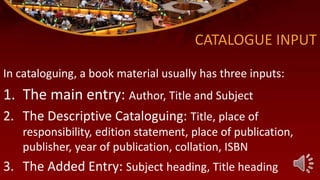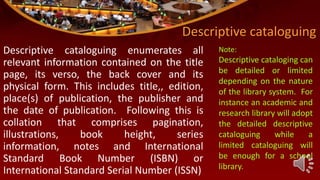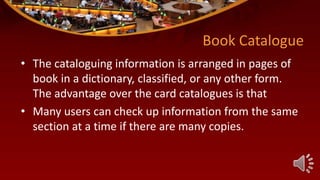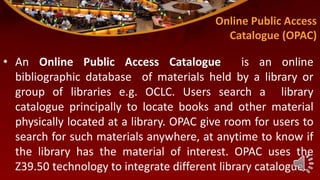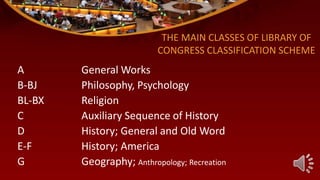cataloguing.pptx
- 1. GNS121: USE OF LIBRARY, STUDY SKILLS & ICT . . Cataloguing By Adesoji David ADERIBIGBE +2348077242945 email: aderibigbead@tasce.edu.ng
- 2. Course Outline âĒ Brief History of the Library, Library and Education âĒ University Libraries and other Types of Libraries âĒ Study Skills (reference services) âĒ Type of Library Materials âĒ Using Library resources including e-Learning, e-materials âĒ Understanding Library Catalogues(Card, OPAC) and Classification âĒ Copyright and its Implication âĒ Database Resources, âĒ Bibliographic Citation and Referencing.
- 3. What is Cataloguing âĒ Cataloguing is a process of making entries into a catalogue in order for users to easily locate the materials in the library. âĒ A process of preparing a book to be put on the shelves. A catalogue is a bibliographic information about the library holdings which make it easy for users to know and access available library resources.
- 4. Objectives of Cataloguing 1. It helps the users to know whether a particular book by a particular author with a particular title, edition, publisher and year is available in the library.
- 5. Objectives of Cataloguing (cont.) 2. The catalogue brings together in a single place all works of a given author whether personal or corporate.
- 6. Objectives of Cataloguing (cont.) 3. The subject catalogue brings together all the works on a given topic in the library.
- 7. CATALOGUE INPUT In cataloguing, a book material usually has three inputs: 1. The main entry: Author, Title and Subject 2. The Descriptive Cataloguing: Title, place of responsibility, edition statement, place of publication, publisher, year of publication, collation, ISBN 3. The Added Entry: Subject heading, Title heading
- 8. Main Entry The main entry is the heading of the bibliographic record through which user can search for the information resources (books, journal, magazine) in the library. Catalogue is designed under three entries: Author, Title, and Subject, after which other information that describe the materials such as, collation, ISBN/ISSN, join authors/editors(if available) and subject headings were written. See this as main entrance to the house through the doors
- 9. Descriptive cataloguing Descriptive cataloguing enumerates all relevant information contained on the title page, its verso, the back cover and its physical form. This includes title,, edition, place(s) of publication, the publisher and the date of publication. Following this is collation that comprises pagination, illustrations, book height, series information, notes and International Standard Book Number (ISBN) or International Standard Serial Number (ISSN) Note: Descriptive cataloging can be detailed or limited depending on the nature of the library system. For instance an academic and research library will adopt the detailed descriptive cataloguing while a limited cataloguing will be enough for a school library.
- 10. Added Entries âĒ Also known as tracings, these are the other entries which cover all the approaches that a user can use to look for material in the library. This includes joint authors, editors, title and series approach. Note: Added entries for subject is indicated with Arabic numeral 1,2,3âĶ while added entries for authors, titles, series, sponsor are indicated with Roman numerals I, II, IIIâĶ See this as entering the house through the windows
- 11. CATALOGUE ENTRIES There are other various ways of entry in cataloguing but the most common are three. These are: 1. Author Heading 2. Subject Heading 3. Title Heading Please note that year, ISBN, publisher and many other fields could also be used to search for materials in online/automated catalogue.
- 12. 1. AUTHOR HEADING ENTRY The author heading covers the name of the principal author, personal or corporate, if any can be assigned the responsibility of the work. Where no clear author emerges the title is used for the main entry. The name of the author starts with the surname followed by the forenames with the inclusion of the date of birth where known as optional.
- 13. 2. SUBJECT HEADING ENTRY Subject headings are used in creating a subject catalogue. Books and other materials on such subject are entered and filed alphabetically. The two most used lists to determine such subject headings are Library of Congress Subject Headings (LCSH) and Sears Lists of A Subject Headings.
- 14. 3. TITLE HEADING ENTRY âĒ The title heading entry starts with the title of the material which is written boldly. Other bibliographic information then follows such as the name of the author, year, place, publisher, ISBN/ISSN etc.
- 15. Various Catalogue Arrangements âĒ Dictionary Arrangements âĒ Author/title Arrangements âĒ Subject Arrangements âĒ Serials Arrangements âĒ Shelf List Arrangements
- 16. Qualities of a Good Catalogue âĒ Comprehensiveness âĒ Easy access âĒ Flexible to update âĒ Cheap to acquire or make
- 17. Forms of Catalogue Catalogue can be in many forms but three of them are commonly seen in the library. These are: 1. Book, 2. Card and 3. Automated or Online
- 18. Book Catalogue âĒ The cataloguing information is arranged in pages of book in a dictionary, classified, or any other form. The advantage over the card catalogues is that âĒ Many users can check up information from the same section at a time if there are many copies.
- 19. Advantages 1. It can be moved from one place to another. 2. It can be easily consulted 3. It is compact 4. Many entries can be consulted at a time
- 20. Disadvantages 1. It cannot be kept up to date due to its fixed nature. New entries cannot be added unless the whole is reissued. 2. It is laborious to prepare and it is very expensive
- 21. Card catalogue The card of 3â x 5â is used to contain the cataloguing information. There is usually a card cabinet with trays which houses the card through a punched hole held by an iron rod.
- 22. Picture of a Card Cabinet
- 23. AUTOMATED CATALOGUE This is a computer based catalogue, designed in digitised format through a computer application. This may be online or offline. Examples of this is Online Open Access Catalogue (OPAC), TASCE Library Automated Catalogue
- 24. Online Public Access Catalogue (OPAC) âĒ An Online Public Access Catalogue is an online bibliographic database of materials held by a library or group of libraries e.g. OCLC. Users search a library catalogue principally to locate books and other material physically located at a library. OPAC give room for users to search for such materials anywhere, at anytime to know if the library has the material of interest. OPAC uses the Z39.50 technology to integrate different library catalogue.
- 25. TASCE OPAC
- 26. Benefit of OPAC âĒ Accessibility any time, anywhere. âĒ Integration of bibliographic information âĒ Possibility of union catalogue âĒ Time saving
- 27. CLASSIFICATION Classification is the systematic arrangement of objects, ideas, books or other materials in the library which have like qualities or characteristics into groups or classes.
- 28. Classification Systems âĒ Library of Congress Classification Scheme âĒ Dewey Decimal Classification Scheme âĒ Universal Decimal Classification Scheme âĒ Bliss Classification Scheme âĒ Colon Classification Scheme
- 29. THE MAIN CLASSES OF LIBRARY OF CONGRESS CLASSIFICATION SCHEME A General Works B-BJ Philosophy, Psychology BL-BX Religion C Auxiliary Sequence of History D History; General and Old Word E-F History; America G Geography; Anthropology; Recreation
- 30. H Social Science J Political Science K Law L Education M Music N Fine Arts, Architecture P Language and Literature THE MAIN CLASSES OF LIBRARY OF CONGRESS CLASSIFICATION SCHEME
- 31. Q Science R Medicine S Agriculture T Technology U Military Science V Naval Science Z Bibliography; Library Science THE MAIN CLASSES OF LIBRARY OF CONGRESS CLASSIFICATION SCHEME
- 32. THE MAIN CLASSES OF DEWEY DECIMAL CLASSIFICATION(DDC) âĒ 000 - General Works (including general encyclopedias, dictionaries, period cab, newspapers etc). âĒ 100 - Philosophy âĒ 200 - Religion âĒ 300 - Social Sciences âĒ 400 - Languages âĒ 500 - Pure science âĒ 600 - Technology âĒ 700 - The Arts âĒ 800 - Literature âĒ 900 - Geography and History
- 33. Thank you







